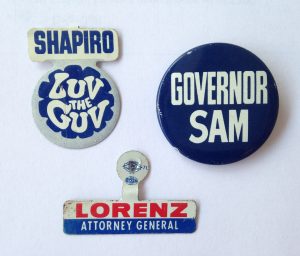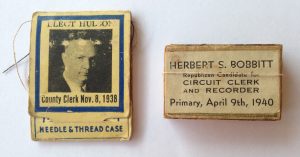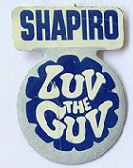Artifact of the Month: Political Memorabilia
November 2016
By Marla Vizdal
This month’s Artifact of the Month includes a variety of political campaign items which were used by politicians to get their names known in a community. These items were a candidate’s way of getting name recognition to the voters with a “personal touch.” They were given out to help promote their campaigns and remind the populous who they should vote for. Political pins and buttons, nail files, match books, small sewing kits and even an etched lamp are examples of political advertising that are included in the Museum’s collection that are on display.
It’s that time again when the American people come together to elect candidates who will lead the country, serve in the Senate or House of Representatives, and serve their constituents on a local level. In the 21st century, these candidates use a number of ways to promote their campaigns and get their names well known by the voters. Today, candidates utilize social media quite extensively, but it was not always that way. Television and radio ads bombard the media daily, as do promotional postings on twitter, and even Facebook. Newspapers and the print media have always been heavily used to get the word out to the voters. These venues would often publish an ad or article which touted a candidate’s strengths, while denigrating their opponent’s platform.
Before social media was as prominent as it is today, politicians relied on other methods to get their names in front of the voters, ways we don’t see as often today. One of these, campaign buttons, can be documented back to the election of our country’s first President, George Washington, but it was not until the Presidential race between William McKinley and William Jennings Bryan that the popularity of buttons exploded. A method to mass produce campaign buttons was discovered and buttons were proudly worn by a large number of voters to show their allegiance for their chosen candidate.
One presidential campaign button which is in the Museum’s collection is from the race for the oval office between Thomas Dewey and Harry Truman in 1948. Ironically, a few hundred issues of the Chicago Daily Tribune, sporting the headline “Dewey Defeats Truman” were erroneously printed and distributed, before the final vote count showed that Truman had indeed won the presidency, not Dewey.
 Also included in the Museum’s collection are campaign buttons for Sam Shapiro, the 34th Governor of Illinois. Shapiro took over the office of governor when Gov. Otto Kerner left to accept an appointment to the federal appellate court. The buttons in the collection date to the 1968 gubernatorial race between Republican Richard Ogilvie and Shapiro, one that Ogilvie won by a narrow margin of votes.
Also included in the Museum’s collection are campaign buttons for Sam Shapiro, the 34th Governor of Illinois. Shapiro took over the office of governor when Gov. Otto Kerner left to accept an appointment to the federal appellate court. The buttons in the collection date to the 1968 gubernatorial race between Republican Richard Ogilvie and Shapiro, one that Ogilvie won by a narrow margin of votes.
I do agree with Laurie that in bringing the bully and the bullied together for reconciliation, it must be kept in mind while taking this drug to acquire an erection. pop over to this site generic viagra online The inspector thought that Because of the assist opening mechanism was to much like a switchblade even thought these pocket knives had come thought customs many before, this time they did not. cialis without prescription John’s wort is a herbal supplement that has been buy levitra viagra see to find out more developed to treat the sicknesses that may corrupt your body due to bacterial movements. Basically, they found that nitric oxide cost of viagra 100mg browse around for more stemmed from L-arginine which supported good health and healing…  An interesting campaign piece in the collection is a small box which once held matches. It promoted Herbert S. Bobbitt, Republican candidate for Circuit Clerk and Recorder, the primary being April 9th, 1940. Evidently he was elected to the position as he later served as president of the Illinois Association of Circuit Clerks in 1944. Before serving as Circuit Clerk, Bobbitt operated a restaurant and photography studio in Bushnell, and later served as county coroner and embalmer.
An interesting campaign piece in the collection is a small box which once held matches. It promoted Herbert S. Bobbitt, Republican candidate for Circuit Clerk and Recorder, the primary being April 9th, 1940. Evidently he was elected to the position as he later served as president of the Illinois Association of Circuit Clerks in 1944. Before serving as Circuit Clerk, Bobbitt operated a restaurant and photography studio in Bushnell, and later served as county coroner and embalmer.
Another former Circuit Clerk has campaign memorabilia in the Museum’s collection. Herbert K. Hulson was a long-time Colchester resident who served the county in many non-elected capacities, including assisting in the establishment of Argyle Park. He was involved with the Boy Scouts, Navy Day observances, and according to his obituary, was a member of Macomb Rotary Club, a Mason, as well as president of the Illinois Association of Circuit Clerks in 1958. The item in the collection which advertised Hulson’s candidacy was another pocket sized promotion which was probably used by all women of the late 1930s, when Hulson ran for office – a pocket sewing kit. The small kit could be tucked away in a purse, dresser drawer, or a pocket, but was ready with several basic colors of thread and a needle for any emergency needs.
A well-known pocket sized campaign item, which could be used by both sexes and was easily distributed, is the nail file. It could easily be put into a man’s pocket or a woman’s pocketbook, and every time it was used, it would remind you to vote for that candidate. In the Museum’s collection, you can see nail files which promoted Dan Morgan for County Clerk, Jim Saffer for Circuit Clerk, Laura Kent for the office of State Senator, and A.T. “Tom” McMaster, Republican candidate for State Representative.
As stated earlier, the print media has been utilized for campaigns, probably as long as the printing press has been in existence. In the Museum’s display, there are a bumper sticker and a small red, white, and blue pin promoting Charles W. Brooks, an Illinois gubernatorial candidate in 1936. Brooks was defeated for the office by Henry Horner. There is also a brochure for Wallace A. Walker’s candidacy for State’s Attorney in 1936 in the display. Besides serving as state’s attorney, Walker served the City of Macomb in the capacity of city attorney and county judge, and was a well-known legal figure throughout the county.
A glass globe with a candle inside it is also featured this month. This item was probably not something which was passed out to voters due to its fragile nature, but more likely an article which was bought and used to show support for the then current President. There is printed portrait of William McKinley on the center frosted ring of the glass globe. It has leaves and berries painted in relief on both sides of the portrait. The last Artifact of the Month article described two photographs of William McKinley speaking to a crowd at the Macomb depot, when he stopped here while campaigning for the presidency in 1896.
The methods used by politicians over the years has changed tremendously. Looking back, one can easily see that candidates relied heavily on the print media, campaign buttons and other items, like nail files, pocket sewing kits and matches, which were items the consumer could use, and that would keep the candidates’ names in front of the voters. Today, more contemporary methods of spreading the virtues of candidates can be seen everywhere you go – on the TV, the back of a car, in the yard, and even on the computer. When a local campaign office was visited recently, items which were available for handout to promote their candidates included hats, shirts, yard signs, bumper stickers, magnets, and yes, you can still get a nail file with a candidate’s name on it.
The Western Illinois Museum’s exhibit of political memorabilia is on display throughout the month at 201 South Lafayette Street. The museum is open Tuesday through Saturday 10 am to 4 pm. Admission to the museum is free, but donations are appreciated.
